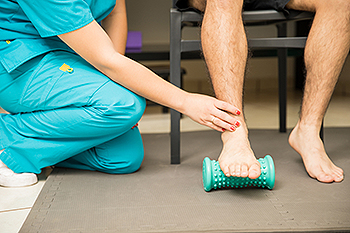6650 Frankford Ave
Philadelphia, PA 19135

If you are a parent, it is important for you to be doing all you can to minimize the extent to which your child could scrape or develop a wound on their feet. If your child is playing outside in the yard, you might, for instance, clear sharp objects like pointy twigs and rocks that could pierce your child’s skin. There are also many helpful ways in which a parent can immediately treat a wound if it develops on the child’s feet. For example, it might be a good idea to clean the affected area and dry it, applying a bandage. Importantly, if your child’s abrasion causes swelling or a fever, medical attention should be sought out. Contact a podiatrist today if you want to learn more about how to protect your child’s feet.
Making sure that your children maintain good foot health is very important as they grow. If you have any questions, contact John M. Fanelly, DPM of Northeast Philadelphia. Our doctor can provide the care you need to keep you pain-free and on your feet.
Keeping Children's Feet Healthy
Having healthy feet during childhood can help prevent medical problems later in life, namely in the back and legs. As children grow, their feet require different types of care. Here are some things to consider...
Although babies do not walk yet, it is still very important to take care of their feet.
Avoid putting tight shoes or socks on his or her feet.
Allow the baby to stretch and kick his or her feet to feel comfortable.
As a toddler, kids are now on the move and begin to develop differently. At this age, toddlers are getting a feel for walking, so don’t be alarmed if your toddler is unsteady or ‘walks funny’.
As your child gets older, it is important to teach them how to take care of their feet.
Show them proper hygiene to prevent infections such as fungus.
Be watchful for any pain or injury.
Have all injuries checked by a doctor as soon as possible.
Comfortable, protective shoes should always be worn, especially at play.
If you have any questions please feel free to contact our office located in Philadelphia, PA . We offer the newest diagnostic and treatment technologies for all your foot and ankle needs.

Plantar fasciitis is one of the most common causes of heel pain. It occurs when a thick band of tissue, plantar fascia, that runs from the toes to the heel under the foot becomes inflamed. It causes a stabbing pain when you get up in the morning, but usually diminishes throughout the day. A number of exercises can help to stretch and strengthen the plantar fascia, thereby reducing pain. To stretch the area, first, while sitting in a chair, lift the big toe upward and gently massage the bottom of the foot. Repeat three or four times. Second, roll a tennis ball under your foot, back and forth. Third, standing up and holding onto a chair or wall for balance, push the toe of one foot against the heel of the other, stretching it. Hold for 30 seconds and then switch feet. Repeat. To strengthen the plantar fascia, sit in a chair and place a towel on the floor. Grab the towel with the toes and hold for 30 seconds. Change feet. This can also be done with a pencil. For more information on how to alleviate the pain of plantar fasciitis, please consult with a podiatrist.
Plantar fasciitis is a common foot condition that is often caused by a strain injury. If you are experiencing heel pain or symptoms of plantar fasciitis, contact John M. Fanelly, DPM from Northeast Philadelphia. Our doctor can provide the care you need to keep you pain-free and on your feet.
What Is Plantar Fasciitis?
Plantar fasciitis is one of the most common causes of heel pain. The plantar fascia is a ligament that connects your heel to the front of your foot. When this ligament becomes inflamed, plantar fasciitis is the result. If you have plantar fasciitis you will have a stabbing pain that usually occurs with your first steps in the morning. As the day progresses and you walk around more, this pain will start to disappear, but it will return after long periods of standing or sitting.
What Causes Plantar Fasciitis?
There are some risk factors that may make you more likely to develop plantar fasciitis compared to others. The condition most commonly affects adults between the ages of 40 and 60. It also tends to affect people who are obese because the extra pounds result in extra stress being placed on the plantar fascia.
Prevention
There are a variety of treatment options available for plantar fasciitis along with the pain that accompanies it. Additionally, physical therapy is a very important component in the treatment process. It is important that you meet with your podiatrist to determine which treatment option is best for you.
If you have any questions, please feel free to contact our office located in Philadelphia, PA . We offer the newest diagnostic and treatment technologies for all your foot care needs.

There are various professions that require standing for the majority of the day. These include retail workers, medical field personnel, and restaurant employees. Research has indicated that many people who endure standing have chronic foot pain. The feet carry the weight of the body, and it is not surprising that foot pain exists. A common foot condition that can be caused by standing all day is plantar fasciitis. This affects the heel and the arch of the foot, and it can cause difficulty in walking. This condition often requires attention sooner than later, relief may be relieved by wearing custom-made orthotics. The feet distribute the weight of the body unequally, as most people alternate their weight between their feet. This can cause overall muscle fatigue, and general discomfort. Additionally, this can negatively affect an employee's performance, as the days are spent in pain. It is beneficial to stand on a stress mat that may help to balance the body’s weight, in addition to wearing comfortable shoes. If you have questions about how to protect your feet while standing all day, please consult with a podiatrist who can address any concerns you may have.
While working on the feet, it is important to take the proper care of them. For more information about working on your feet, contact John M. Fanelly, DPM from Northeast Philadelphia. Our doctor will treat your foot and ankle needs.
Working on Your Feet
Standing on your feet for long periods of time can cause stress and pain in your feet. Your whole body may experience change in terms of posture, back pain, bunions, callouses and or plantar warts. There are ways to avoid these conditions with proper foot care, smart choices and correct posture.
Positive Changes
Negative heeled shoe – Choosing this shoe type places the heel slightly lower than the ball of the foot. These are great for overall foot health. Find shoes that fit you correctly.
Go barefoot – Our feet were not designed to be enclosed for all hours of the day. Try to periodically expose your feet to air.
Eliminate Pain
Foot Exercises – Performing simple exercises, incorporating yoga and doing stretches are beneficial. This will allow increased blood flow to the area and muscles of the foot.
Achilles tendon – Stretching the foot out flat on the floor will relax the calf muscles and tendon. These exercises can be performed almost anywhere. Make sure you add these exercises to your daily regimen.
With a little bit of this information and knowing more about foot health, you will notice changes. Foot stretches and proper footwear will help with pain and prevent further issues.
If you have any questions please feel free to contact our office located in Philadelphia, PA . We offer the newest diagnostic and treatment technologies for all your foot and ankle needs.

The foot condition known as athlete’s foot can be uncomfortable. In severe cases, blisters can develop on the feet and often between the toes. Athlete’s foot is caused by a fungus, and can enter the body through small cracks in the skin on the feet. The symptoms it can produce are red skin and itchiness, and the feet are often dry and scaly. The fungus that causes athlete's foot lives and thrives in warm and moist environments, including public swimming pools, locker rooms, and shower room floors. Effective preventive methods can consist of washing and drying the feet thoroughly, and refraining from sharing shoes and socks. Additionally, it is beneficial to wear appropriate shoes, such as flip flops or water shoes, while in these types of areas. Any severity of athlete's foot is often seen by a podiatrist to ensure it is diagnosed and treated properly, and it is suggested to schedule an appointment as quickly as possible if you have this condition.
Athlete’s Foot
Athlete’s foot is often an uncomfortable condition to experience. Thankfully, podiatrists specialize in treating athlete’s foot and offer the best treatment options. If you have any questions about athlete’s foot, consult with John M. Fanelly, DPM from Northeast Philadelphia. Our doctor will assess your condition and provide you with quality treatment.
What Is Athlete’s Foot?
Tinea pedis, more commonly known as athlete’s foot, is a non-serious and common fungal infection of the foot. Athlete’s foot is contagious and can be contracted by touching someone who has it or infected surfaces. The most common places contaminated by it are public showers, locker rooms, and swimming pools. Once contracted, it grows on feet that are left inside moist, dark, and warm shoes and socks.
Prevention
The most effective ways to prevent athlete’s foot include:
Symptoms
Athlete’s foot initially occurs as a rash between the toes. However, if left undiagnosed, it can spread to the sides and bottom of the feet, toenails, and if touched by hand, the hands themselves. Symptoms include:
Diagnosis and Treatment
Diagnosis is quick and easy. Skin samples will be taken and either viewed under a microscope or sent to a lab for testing. Sometimes, a podiatrist can diagnose it based on simply looking at it. Once confirmed, treatment options include oral and topical antifungal medications.
If you have any questions, please feel free to contact our office located in Philadelphia, PA . We offer the newest diagnostic and treatment technologies for all your foot care needs.